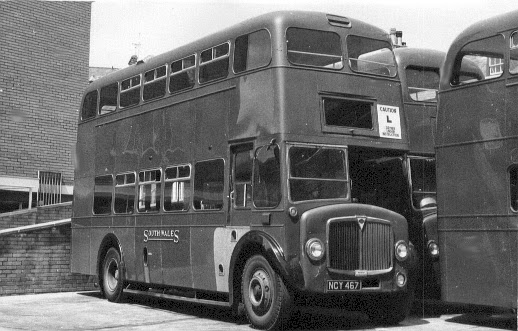(First
published in the South Wales Evening Post, Monday January 12 2004.)
 |
| A rare colour shot of
one of the 400s in action. This is 487 passing Singleton Park on Sketty Road en route for Langland Bay on service 87. |
The AEC legacy lives on in the many hundreds of vehicles now in preservation and in the substantial number of 1960s built ‘Routemaster’ buses still to be seen on the streets of central London.
Difficult
South Wales once was part of the AEC empire. In particular, South Wales Transport often tried out new designs in service on its difficult operating territory in Swansea; the steep hills were found to be an excellent proving ground! SWT also was often amongst the forerunners when it came to purchasing large numbers of new designs having, it can be assumed, seen the prototypes operating successfully!
Of the many AEC bus designs which operated in this area, the ‘400s’ are well remembered. The name refers to a batch of AEC Regent Mark Five double deckers numbered in the 400 series and whose most distinctive trademark was the growling AV470 engine, often heard several streets away! Perhaps they weren’t really that loud; there was less traffic in those days...
 |
| 482 at rest at Brunswick Street garage, Swansea. |
There were three basic varieties of ‘Four Hundreds’; normal height with Weymann bodywork, normal height with Willowbrook bodywork and the low height Weymann design. All had their entrances at the rear.
Smart
The first deliveries were the normal height Weymann type (numbered 440 to 449, MCY 400-409), looking very smart in their deep red and cream livery. Indeed, the type was the last to carry the cream waistband which was a feature of the 1960s fleet.
The earliest examples were allocated to Llanelli and some had platform doors at the rear - unusual in the SWT fleet and reportedly for use on the Llanelli to Swansea service 2.
 |
| Recreating a scene from yesteryear, 447 waits at the bus shelter near Llanelli Rail Station. Incidentally, the blue post was a survivor from Llanelly (sic) trolleybus days. |
 |
| Sole survivor, 447 (MCY 407) on its old stamping ground at Llanelli. |
Coinciding with the delivery of the first batch were 450-459 (MCY 410-419). These had low height bodies with a sunken gangway and bench-type seating on the upper deck. Generally they were used on interurban services between for example, Swansea and the Swansea Valley. They were renumbered in the low height series as 1189-1198 in 1958.
Further high bridge examples were delivered in 1956 (460-480, NCY 451-471) and 1957 (481-500, OCY 664 -683). These were all of the Weymann type except 491-500 which were of the rounder appearance Willowbrook design.
 |
| A
wet day in Caer Street, Swansea. 487 illustrates the Weymann bodied
variety, followed closely by 494 with Willowbrook behind. |
Film
 |
| Celebrity 476 when new. It later appeared in the 1961 film, ' Only Two can Play' starring Peter Sellers, scenes for which were shot in Swansea. |
 |
| Stills of 476 (NCY 467) taken from the 1961 film, 'Only Two can Play' starring Peter Sellers. |
 |
| NCY 467 once again - by now a training vehicle at Brunswick Street depot. |
The Willowbrook bodied examples, having spent their early years in Swansea were later transferred en bloc to Llanelli. At around the same time they each lost their cream waistbands and saw out their days in overall red, 496 and 498 lasting until 1974 as driver training buses. The pair were last seen on the scrap line at Neath, eventually being towed to Yorkshire for breaking.
Withdrawn
Many of them therefore had several years of life left in them and were soon snapped up by operators such as Smiths of Reading or Ledgard of Leeds and once again found themselves in front line service. Others passed to contractors and a variety of minor operators including one who used ran hop-pickers’ services in Kent.
And so, a well-loved type passed into history with 447 now as the last known survivor of the SWT ‘Four Hundreds’.
It is worth noting that when SWT had purchased early examples of AEC Regent Vs in 1955, it would clearly, eventually, become amongst the first to take them out of service. SWT was totally unique at that time in replacing one batch of Regent Vs with a more modern version of the same marque; these were to become known as the ‘Six Hundreds’ and remain a story for another day!


No comments:
Post a Comment